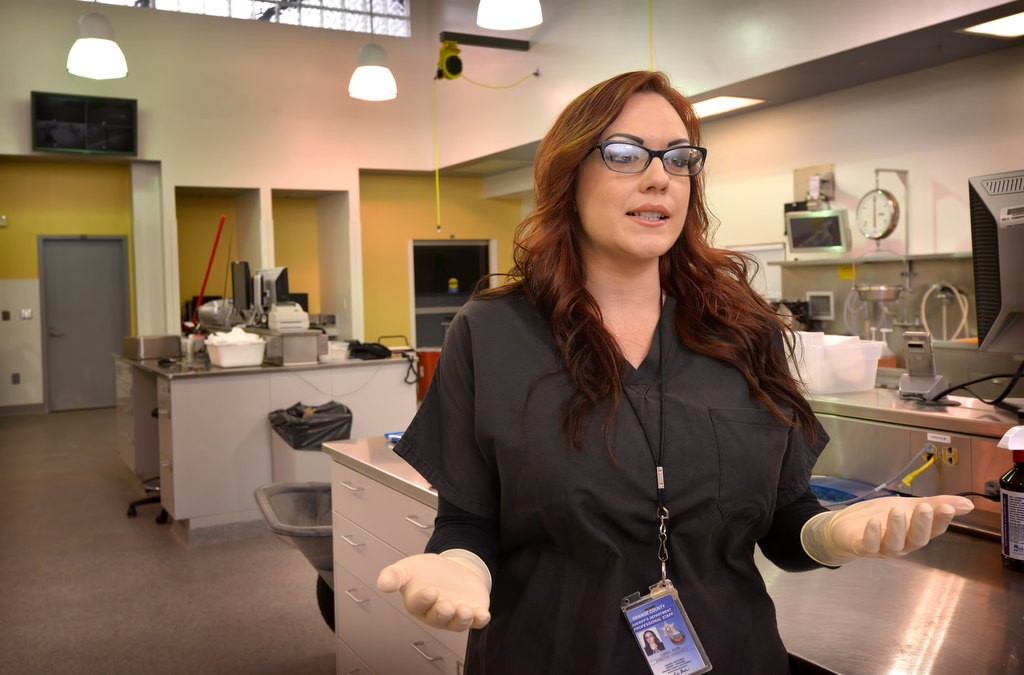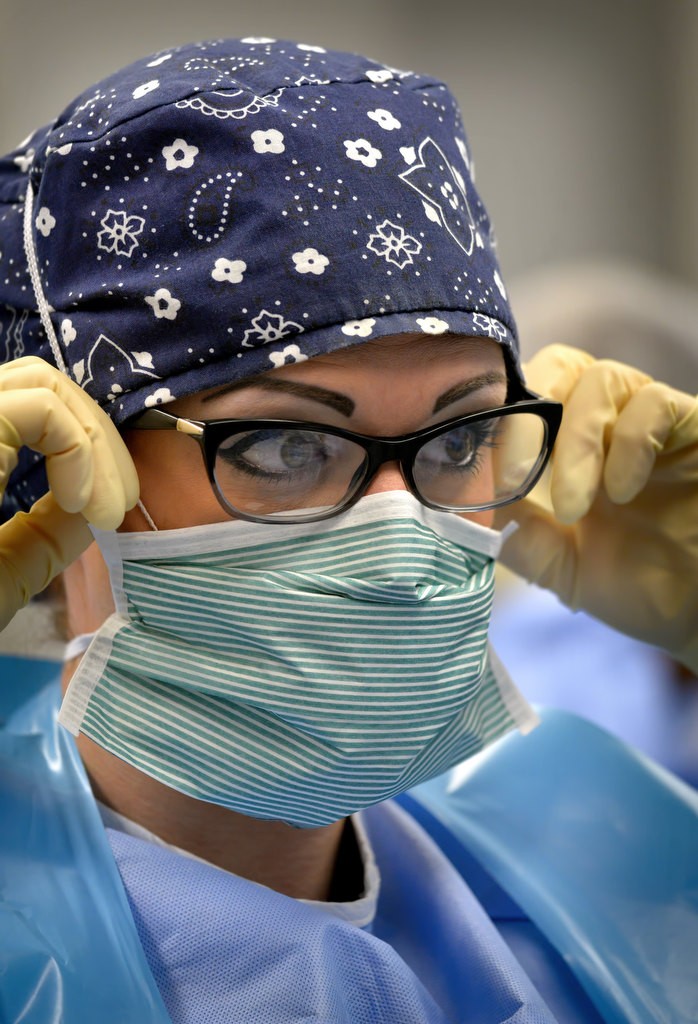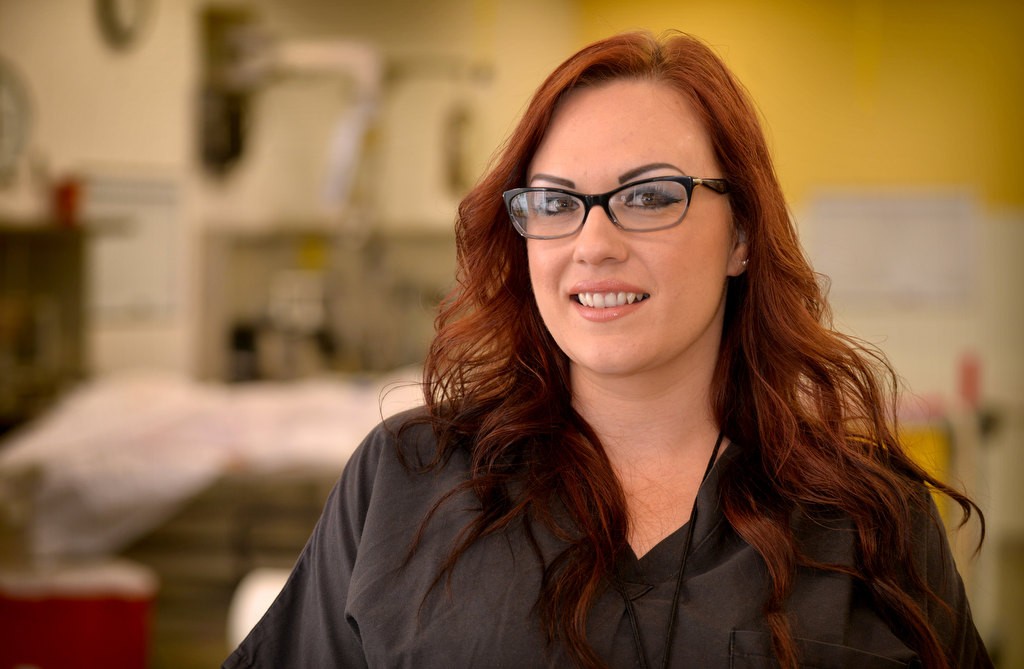When people find out what Loria Bair does for a living, she typically gets one of two responses. There’s the “tell me more.” And then there are those who are appalled.
As a forensic assistant for the Orange County Coroner’s Office, Bair sees all the gory details – much more than that, in fact.
Each autopsy performed at the Coroner’s Office is conducted by a forensic pathologist (a doctor) who inspects and biopsies each organ and otherwise thoroughly examines the body in order to determine cause of death.
At his or her side is the forensic assistant, who is fully involved in extracting organs, fluids, tissue and anything else the doctor needs for the examination.
It’s a job many people may not have the stomach for, but an important one in the criminal justice process.
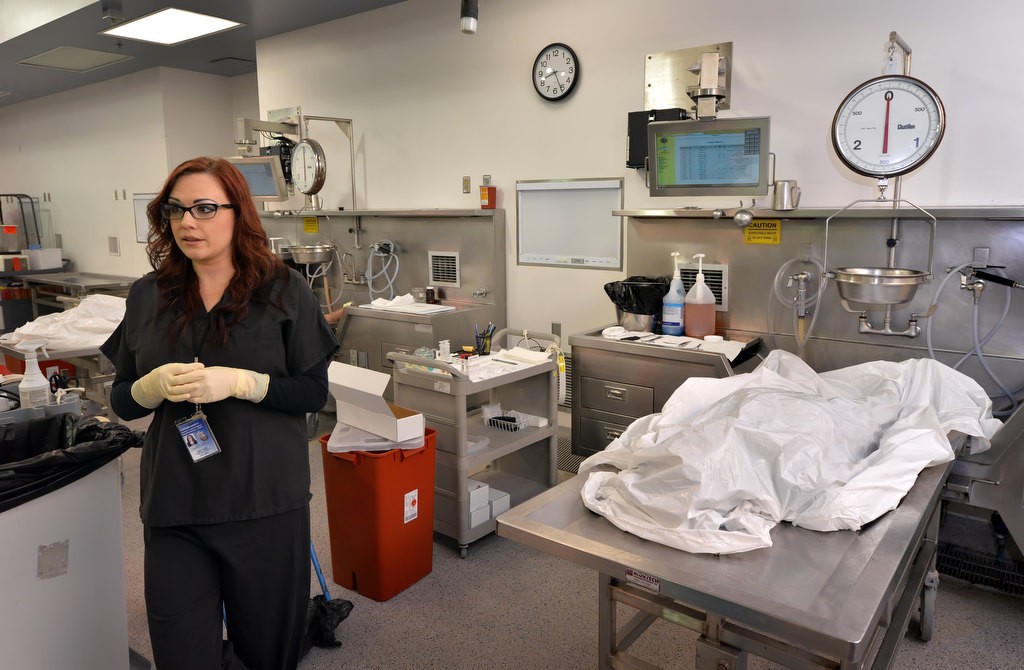
Loria Bair, forensic assistant, talks about the department she works for before the team, which she is part of, starts on the autopsies planed for the day.
Photo by Steven Georges/Behind the Badge OC
“Yeah, we do cut dead bodies … but there’s so much more to it,” says Bair, referring to those who can’t fathom doing her job.
Bair, who worked at a mortuary/crematory for seven years before starting work at the Coroner’s Office three years ago, knows that a determination of cause of death can help bring families some degree of closure in the most difficult time of their lives.
“Maybe that person who committed suicide, maybe they had chronic debilitating pain or sickness from an undiagnosed cancer,” Bair says, as an example. “That could give some sort of reason or closure to why they would do that.”
Then of course, there’s the main reason why an autopsy would be performed: any unexpected, traumatic or suspicious circumstance. An autopsy can determine whether a death is a homicide, an accident, suicide or from natural causes, and what the ultimate cause was. That determination alone can be the difference between a full criminal investigation and no further investigation.
An autopsy is a key part of any death-involved investigation.
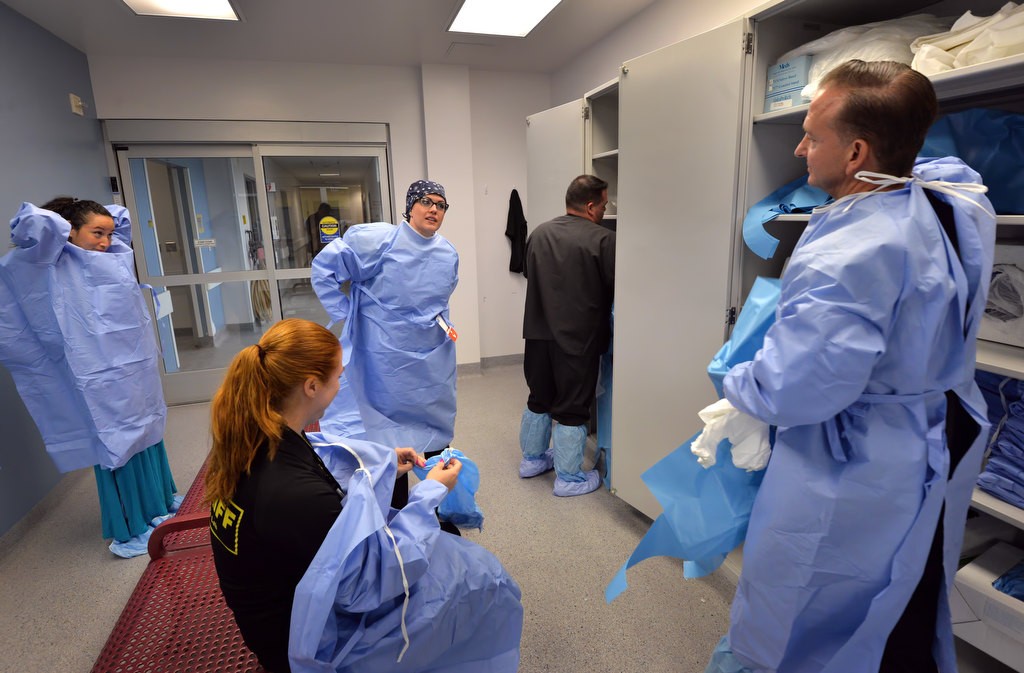
Loria Bair, center standing, dresses in her scrubs as the team gets ready to perform autopsies.
Photo by Steven Georges/Behind the Badge OC
Prep work
There is a systematic process for receiving a body at the Coroner’s Office. Digital or traditional ink fingerprints are taken. If bullets are involved, digital X-rays are also done.
“So we’re not just blindly going in hoping to find something,” Bair says.
With five doctors, the team can perform as many as five autopsies simultaneously in the large autopsy room. When an autopsy is conducted, it is a full autopsy (never partial) no matter what the circumstance. That isn’t the case for all jurisdictions.
Each autopsy station is equipped with a metal table, hose and tools and containers necessary for the procedure. There are two autopsy rooms available for cases requiring investigators or other observers onsite. They can communicate with the doctor and forensic assistant through a speaker system.
Though autopsy length can range dramatically, they average around 45 minutes. More complicated cases take longer.
“A homicide that involves multiple gunshot wounds and projectiles or multiple stab wounds can take upward of up to three hours,” she says. “Locating the projectiles, tracing the trajectory of injury from bullets or stabbings and allowing time for our Crime Lab staff to do their part during autopsy of collecting trace evidence all takes time.”
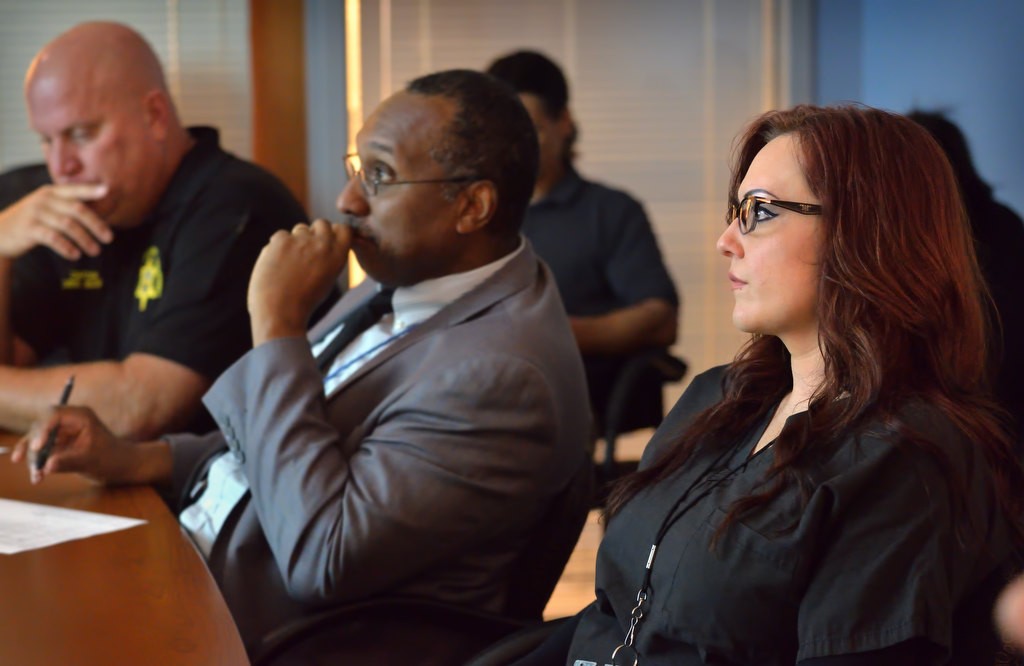
Lorai Bair, forensic assistant for the Orange County-Sheriff Coroner, right, attends a meeting with other members of the OCSD Coroner’s Division as they review the cases they are working on before the start of the day’s autopsies.
Photo by Steven Georges/Behind the Badge OC
Not for weak stomachs
After a morning briefing discussing the day’s autopsy cases, the doctors and forensic assistants suit up in gowns, smocks, gloves, masks, face plates – all securely taped. It’s a messy job.
Though the number of autopsies at the Coroner’s Office typically average between eight and 12 a day, there are only four cases scheduled on this particular Tuesday.
Bair heads to her autopsy station where the body of a man found pinned under his RV awaits autopsy.
Bair and the doctor work in sync, each handling her task adeptly.
The doctor begins by going over the externals on the man’s body, noting scars, markings, eye color and the overall condition of the body. Bair helps move the body on its side for further inspection.
The doctor notes dried grease on the man’s face.
Once the initial inspection is complete, Bair makes a Y-shaped incision on the chest and begins to systematically get through the layers of skin, fat and bone that protect all humans’ internal organs. She uses forensic clippers to cut the rib cage.
When Bair removes the chest plate, she sees hemorrhaging under the plate.
“So we got a break in the sternum,” she says, adding that there was some kind of pressure on the man’s chest. It could be from CPR performed by paramedics or something else.
Bair and the doctor work together through the body, removing each organ or gland, rinsing it, weighing it and placing it in a metal container for samples to be taken by the doctor. As they work, the doctor examines the organs. She notes that the man appeared to have a healthy heart.
They do discover that the man had gall stones – literally a handful of stones in the gall bladder.
Bair uses a syringe to take a blood sample from the aorta. She also obtains a urine sample directly from the bladder. She collects the stomach contents as well, which are minimal.
After further examination off the heart, the doctor confirms the man’s heart was strong and unlikely he died of a heart attack.
When examining the lung organ, the team notes blood – supporting the notion that the man was crushed before death, not after.
Next, Bair cuts the scalp and removes it. She looks for fractures or any abnormalities on the skull. Everything looks normal. She then uses a forensic saw affixed to the station to cut the skull open. The brain is removed.
Bair takes the pituitary gland for examination as well. It’s about the size of a fingernail.
“It’s such a pertinent piece of us as humans,” she says.
Using a tool, she removes the dura mater (membrane) from inside the skull so she can more thoroughly inspect the skull for fractures. She finds none.
All the samples have been taken and are marked as evidence. The organs are bagged and kept with the body during transport to the mortuary. Bair sews the body up.
The doctor rules the death an accident.
How she does it
Bair has never been squeamish about blood, organs or anything of the sort. She says her mom couldn’t understand why she wanted to watch graphic medical shows when she was a kid. To Bair, it was just fascinating.
But it is intense work, and while the blood might not get to her, there are cases that can be tough on an emotional level – for instance, cases of abused or neglected children.
If she’s stressed over a case, she will talk to a co-worker about it. But after that, she has to let it go.
“I can’t hold onto it,” she says.
What motivates her is that ultimate search for truth. If a family thinks their child was murdered and he wasn’t, any small bit of comfort that knowledge may provide is what drives her.
“You have to have compassion, you can’t let it leave you,” Bair says.
In that pursuit of knowledge, the one thing Bair makes sure to do before going into each autopsy is keeping an open mind and not forming any preconceived notions about what happened.
“I try to stay open to each case,” she says.
Between moving 200-pound-plus bodies and cutting through bone, it’s a physical job. And even without being squeamish, the smells and other things that can surround death, including maggots, can be challenging at times.
“It does get gross sometimes, it really does,” she says. “You find your coping mechanism.”
She tries not to think about it.
Though autopsies are the more high-profile part of her job, there is much other work to be done when the autopsies are over – including categorizing, organizing and sorting through the various blood and tissue samples housed at the Coroner’s Office.
Regardless of what she’s doing, the work she does has helped her have a healthy perspective on life.
“My job has given me an amazing balance to life,” she says. “It has helped me appreciate the human need for adventure, our curiosity and generally just living life to the fullest. It also keeps me grounded and realistic.”
 Behind the Badge
Behind the Badge

